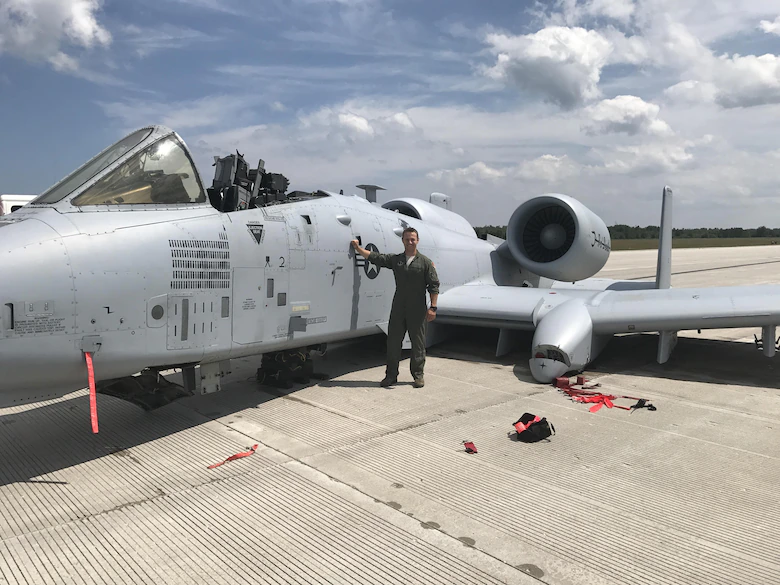Remember the poor A-10 pilot whose canopy blew off after firing the aircraft’s 30 mm cannon? That was Major Brett DeVries from the Air National Guard, who was on a routine training flight when a malfunction exposed him to 400 mph wind rushing over his aircraft. After guiding his stricken aircraft back to base, he crash-landed the 20-ton aircraft and managed to climb out unscathed. After three years of repairs, his companion on that day, A-10 80-0264 is back in the air.
The A-10 has been in the repair shop for three years after its pilot belly-landed the aircraft as its landing gear had failed. DeVries, who was a captain at the time, landed the aircraft in what the former secretary of the Air Force described as an “extraordinary” feat of flying.
For bringing the aircraft down after the unforeseen malfunction, DeVries was awarded the Distinguished Flying Cross.
Belly landing
The incident happened on July 20 2017. DeVries, from the Michigan Air National Guard, was in the seat of his A-10 Thunderbolt II and participating in a training mission over the Grayling Air Gunnery Range.
The mission was routine, and according to DeVries, one that he had performed hundreds of times before. On this particular flight he carried out six bomb passes and one strafing run successfully, but when he fired the famous 30 mm GAU-8/A Avenger cannon on his second strafing run, the aircraft suffered a serious failure. This failure blew off the canopy of the A-10, dazing DeVries and blasting his maps and paperwork out the cockpit.
“It was like someone sucker punched me,” DeVries said. “I was just dazed for a moment.”
Luckily, the malfunction did not compromise the aircraft’s ability to remain in the air, which is not surprising considering the A-10 is world-famous for its reliability and ruggedness. DeVries, who has flown over 100 combat missions overseas, instantly reverted to his wealth of experience and increased his altitude, from 150 to 2,000 feet.
DeVries’ wingman, Major Shannon Vickers, checked over the damaged aircraft and the two calmly planned their next move. They decided DeVries should lower his landing gear. Unfortunately, the nose gear remained tucked away inside the aircraft. As aviation enthusiasts know, landing with the gear down is best, landing with the gear up isn’t ideal, but landing with some down and some up is bad.
Knowing this, DeVries retracted his gear and went in for a belly landing at the Alpena Combat Readiness Training Center. Without a canopy, he managed to pull off a textbook belly landing and climbed out of the aircraft completely unscathed. He had also kept the damage to the A-10 itself to a minimum.
He did this so successfully in fact that his A-10, tail number 80-0264, is now back in the air.
Repairing the A-10
The aircraft was delivered to Hill Air Force Base in 2018 for repairs.
“We knew we could do it, but it would take a long time,” the 571st Aircraft Maintenance Squadron planning chief Daniel Wise said.
He added that “We basically rebuilt the entire front of the A-10 without aided engineering and unprocurable parts that had to be locally manufactured.”
Surprisingly, the belly landing did little to the aircraft, with much of the damage being caused by the malfunction of the 30 mm rotary cannon.
“There’s a main nose beam right next to the gun that blew up, so the inside of the entire gun cavity had to be rebuilt.” Scott Oster said, the 571st AMXS lead A-10 planner. “It was just a whole lot of structural work, like 90 percent.”
The work has taken so long not for a lack of skill or effort, but due to difficulties in sourcing parts. Much of this is down to the US Air Force’s ongoing efforts to retire the legendary attack aircraft. Although these efforts have faced resistance thanks to the A-10’s unique capabilities that are hard to match, the Air Force no longer has a surplus of replacement parts for the aircraft.
Manufacturers haven’t built these types of parts for this aircraft for years, so when attempting to repair the extensive structural damage to 80-0264, the maintenance team had to produce many of the parts themselves.
“A lot of the parts are unavailable so we have to run them through our local manufacturing process and make them ourselves,” Oster said. “With any of the other weapons systems, if they have a bad part, they order it through supply and replace it. On the A-10’s, we’re kind of in a different world.”
The elite engineers at Hill AFB were critical to this, as they are the only people who can complete such requests for the A-10.
With so many A-10s being grounded, it’s great to see one returning to the air.
